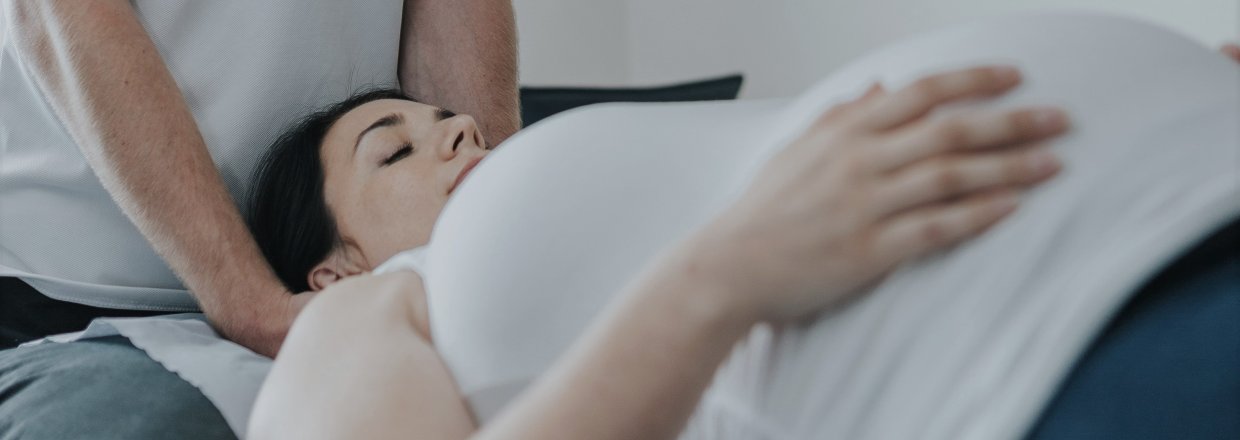Changes to how your body looks can happen not only during pregnancy, but also after welcoming your new arrival. These can be worrying, especially if they are new to you – but are often more common than you may think. One such condition you may encounter or hear about is “Diastasis Rectus Abdominis”.
Kirsty sees the condition often, and knows many women can feel self-conscious and anxious about the impact it can have, and so wrote this piece to help ease those worries, and show how you can access support to help you get back to feeling your best.
What is diastasis rectus abdominis?
Diastasis rectus abdominis (DRA), also referred to as 'mum tum', 'mummy tummy' or 'mummy gap', is the thinning and widening of the connective tissue that runs down the rectus abdominis (six pack) muscle. As this connective tissue widens, the rectus abdominis muscle moves further apart causing a ‘separation’.
It can happen at any part along the middle of the tummy muscle, from just under the rib cage to just above the pubic bone.
What causes the condition?
The widening and thinning of the connective tissue is a normal part of pregnancy, due to the abdominal muscles becoming longer and weaker as the bump grows. DRA is common and is seen in between 30% and 70% of pregnancies.
Not only is it normal, it is also actually necessary in order to create enough room for the baby to grow. Although DRA can improve naturally within eight weeks postpartum, it can be found in up to 32% of women at 12 months postpartum.
DRA can also occur in men and children, although this is usually linked to obesity and/or elite athletes.
What are the common symptoms of diastasis rectus abdominis?
Diastasis rectus abdominis is often detected by physical changes to the look of your stomach. When you lift things, get up from sitting or get out of bed, a ‘doming’ may appear in your tummy. You may also notice a ‘hollow’ in your tummy muscles when laid down.
Further symptoms include abdominal pain or discomfort, or excessive bloating. Occasionally DRA can cause lower back or pelvic pain, but this is not always present.
To help diagnose the condition, a physiotherapist can perform an assessment to establish if there is a separation present. This may be done through palpating (feeling) your tummy muscles in different positions, and check your abdominal strength during different activities.
DRA can also be diagnosed through a ‘self-assessment’ during an online consultation, where your physiotherapist can guide you over a video call.
Is the size of the separation important?
Although DRA is diagnosed by assessing your abdominal muscles and a separation being present, the size of the separation isn’t the focus of the treatment.
Recent studies have helped us understand that focusing on tension and strength across the abdominal muscles is more important to improve physical appearance, reduce symptoms and improve general functions.
How can physiotherapy help?
Exercise is an effective tool to improve postnatal DRA and associated symptoms. It can also be helpful during pregnancy to reduce the risk of symptoms persisting postnatally. An exercise plan should be specific and individualised to each person, which is where physiotherapy becomes important.
A physiotherapist can assess your DRA effectively and determine which activities and exercises you should begin with to aid your recovery. Your rehabilitation plan can then be slowly progressed to meet your personal goals.
A physio can also help set realistic and positive expectations, with emphasis on restoring function and enabling you to take part in your hobbies and usual activities.
The type of treatment and other forms of intervention that a physiotherapist may try include:
- Abdominal strengthening exercise
- Breathing techniques
- Relaxation techniques
- Postural advice
- Behaviour modification to help with activities of daily living (ADLs), hobbies, and/or work
- Advice regarding sleep
- Dispelling fear
- Manual therapy if indicated
The first thing to remember is that it’s not all about the gap! With the correct guidance, you will be able to improve your strength and function even if the gap does not reduce significantly.
Self-managing the condition
Some simple changes to your day-to-day activities can be extremely helpful in managing your symptoms, including:
- Try to avoid sitting up forward from lying down position. If possible, roll onto your side and lower your legs off the bed/sofa, then use your arms to push yourself into sitting
- Where you need to lift something, try to remember to keep the load close to you, to pull your tummy muscles in and squeeze your pelvic floor as you lift, this will help keep you strong
- Start your pelvic floor exercises as early as possible – your physiotherapist can help you with this, and there are also some helpful phone apps such as Squeezy
- Try to avoid constipation, please speak to your GP if you are struggling with this
How can I access physiotherapy treatment?
If you are looking for obstetrics related physiotherapy (antenatal or postnatal care) please call our customers services helpline (0330 678 0850) for a remote initial assessment with one of our specialist trained therapists. They will assess your symptoms virtually and ensure you continue your treatment with the most appropriate therapist for your needs.
Please note we cannot support the following conditions:
- Caesarean section – scar site management advice
- Sexual Dysfunction – vaginismus/dyspareunia
- Transgender care
- Perineal tears
